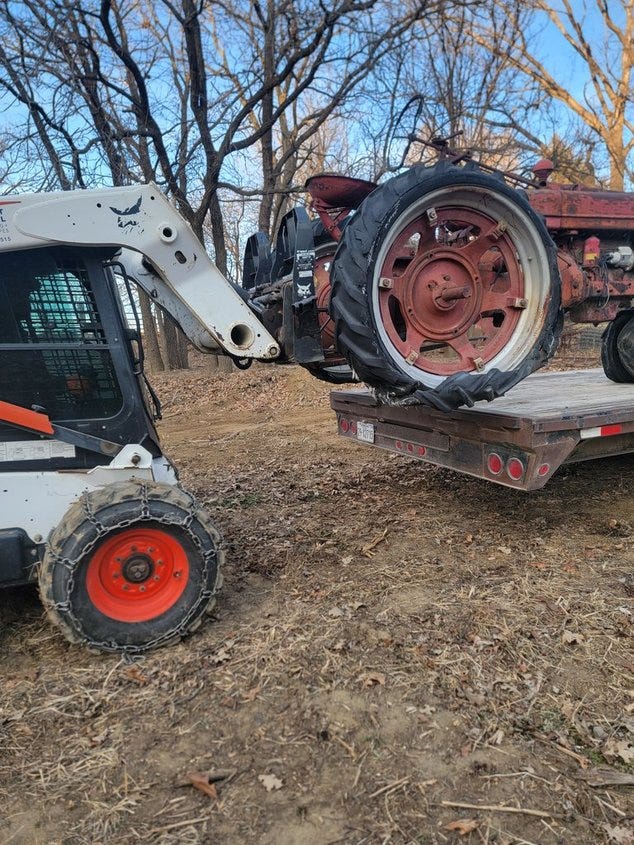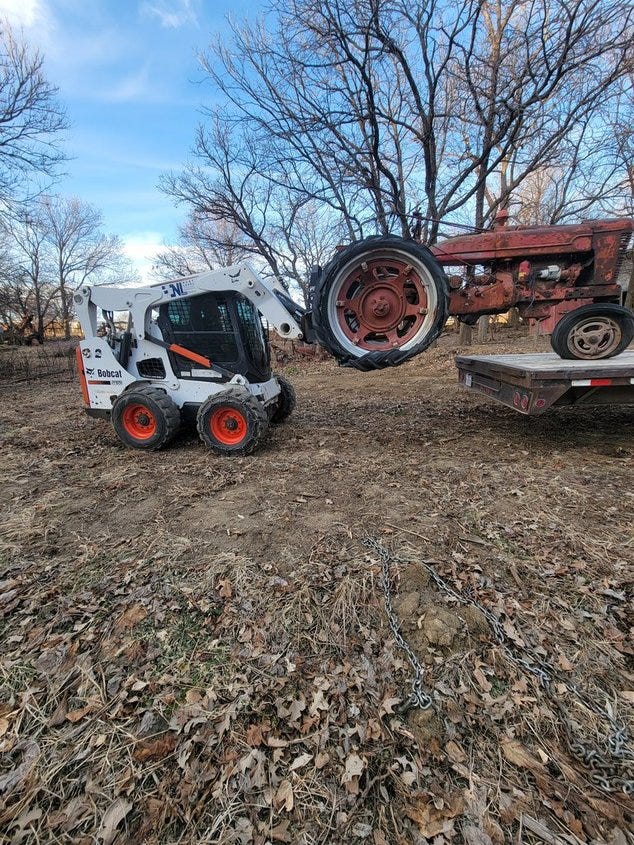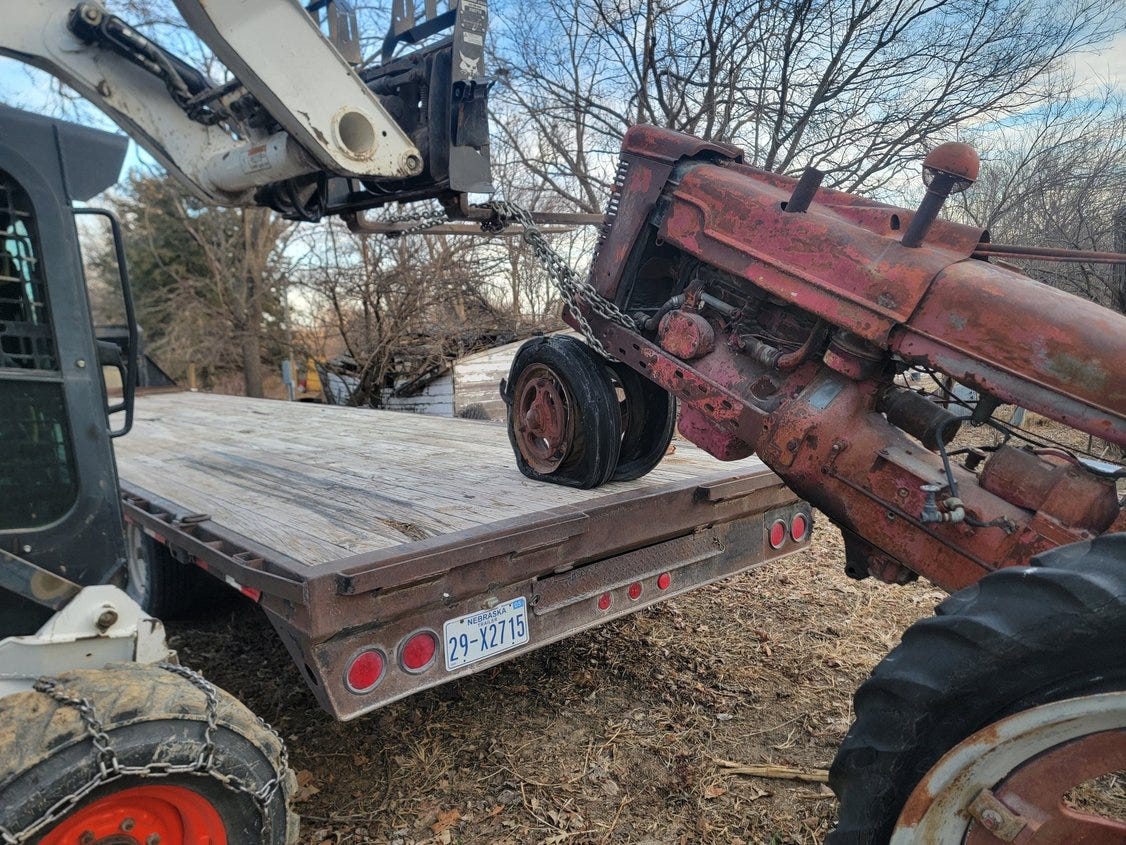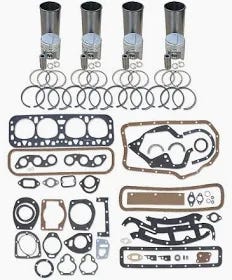My son and I recently made another short rode trip to Springfield Nebraska, about 40 miles south of home. This time to pick up a parts tractor.
I am restoring the Farmall H I started farming with. I need a couple of rear wheels as the ones on mine are rusted out because I ran it with calcium in the tubes because I used it as a loader tractor in the past and needed the ballast to keep the back end from coming off the ground. These filled tires eventually start leaking and of course ruin the rims.
The tractor I purchased would not start and the transmission was also locked up. Either the clutch is rusted - a fairly easy fix. Might be able to go through an inspection plate and hammer on it a little or worst case split the tractor. Since I’m not thinking of restoring this new tractor I am not concerned. It did make it hard to load.
We ended up using a skid steer to pick the front end up and put it on the trailer then lifted the back and pushed it on to the trailer. That took about 10 minutes and then about the same to chain it down for the ride home.
Once home we unloaded it the same way we put it on.
I have no idea how we ever run this farm without a skid steer. It truly is a amazing versitle machine that comes in handy far more often than I would have ever guessed. We use it to do things you absolutely could never do with any tractor.
The engine is more than likely froze up on this one. The previous owner did not cover the exhaust manifold so rain, snow and dirt entered the engine. These engines are realatively simple to rebuild as they have sleeves. They have dry sleeves so different than the wet sleeved tractors like my Case 1070. Dry sleeves are surrounded by the metal block. Wet sleeves are in direct contact with the engine coolant. The wet sleeves last longer, but require precise line up and tools. Wet sleeves started coming on the scene after WW2. The technological advances of the time made wet sleeves a viable technology.
These fit inside the block. You take the oil pan off and hit the top and bottom with penetrating oil and sooner or later they will come out. Put new ones in along with new piston rings and you have a new engine.
A rebuild kit with everythig you need is around $600.00
This video goes through the steps of resleevig a Farmall H.
A history of the Farmall H.
The Farmall H is a medium-sized two-plow row crop tractor produced by International Harvester under the Farmall brand from 1939 to 1954. It was the most widely produced of International Harvester's "letter series", with 391,277 produced over the 14-year run. 27,948 per year! Mnay tractors from the 1970’s on did not see that number of units produced in their whole model run life.
Wheel base of 88.325 inches
Weight 3875 lbs
Band brakes
17.5 gallon fuel tank
24.17 horsepower
1939-1953 manufacturing years
391,277 built
Cost was $2000.00 in 1953
The H came in three fuel types
Gasoline, distalate and Kerosene. The distilite and Kerosene models have a small tank for gasoline to start as gasoline is more explosive. The distalate and kerosene models are pretty rare.
Gasoline had the most horsepower and torque, distilate is a low grade kerosene that was not filtered or cracked as much as kerosene.
They came witha 5 speed manual transmission
With a top speed of 16.4 mph it may seem slow, and it is. However when you first start driving one that 16.4 is plenty fast as the front end can shimmy, you’re on a open station tractor with no seat beat and just a metal pan seat. Most of my field work was done in 3rd or 4th gear. The H was my go to for cultivating. It was easy to handle, had plenty of power to cultivate in 4th gear. I mostly cultivated at night. it was just easier as all you had was the lights pointing down the row and it was cooler without the sun beating down on me. 5 mph cultivating is crusing right along.
That 17.5 gallons of fuel would last 8-10 hours sometimes more. Believe me 8 hours on one of these will beat the snot out of your knees, back and neck and you will be tired at the end of the day.
Overall they were dependable work horses and for their time were big enough to do most things on the farm at that time.
My grandfather used a Farmall H to farm his 160 acres. My dad used a Farmall M Diesel. Him and his brother farmed over 640 acres running that tractor 24x6 during the spring, each running it 12 hours shifts. The only stop was for fuel and Saturday night for a dance or to go to town. These two models were the work horse of the 40’s and 50’s.
I always hate to see this old iron end up on the junk heap. They each have a unique story, its just too bad they cannot talk. The Farmall H and M had a great part of making the USA the food power house producer we became during WW2.
Many are still around today but slowly they are being parted out as they break down.
This particular tractor was purchased by the previous owner 20 years ago with the intention of restoring it. Time marched on and life got busy. Now he is moving and jsut decided that he was not taking it with him.
My plan is at this time to take the rims off so I can get my original H fixed up. Then I’ll probably tear into this new one and see if its worth fixing.













My dad was in ag related business. I remember seeing many of these type of tractors on farmsteads in the 50’s and 60’s . Farms were smaller then and wild life was more common on each farm. Totally miss the hunting back then. We had a small Farmall and Ford tractors on our acreage.